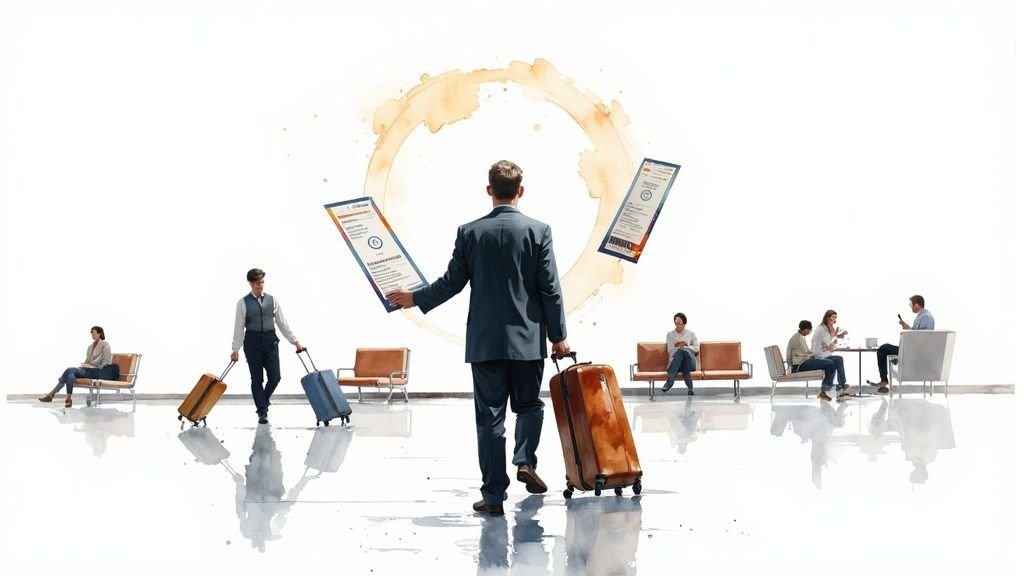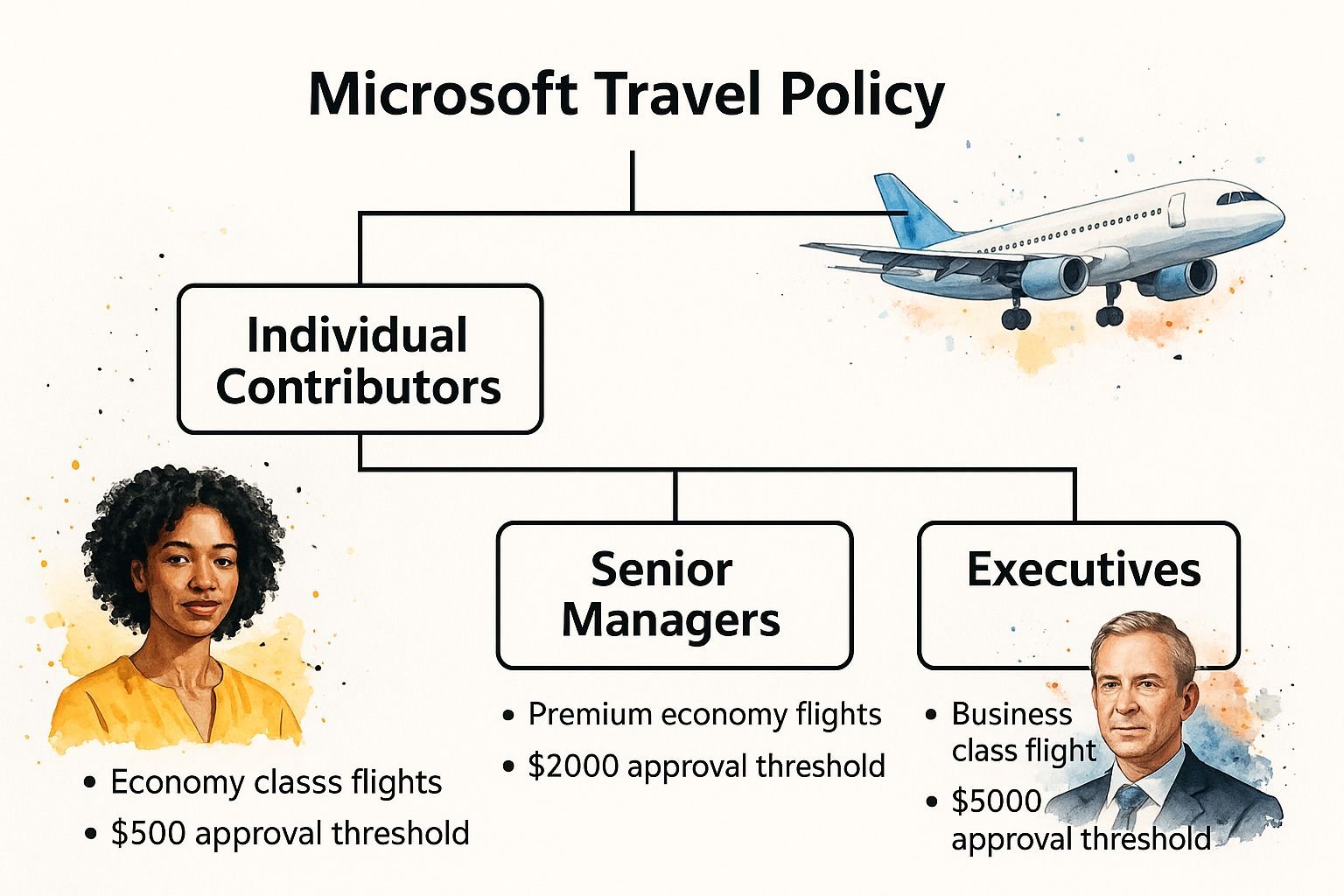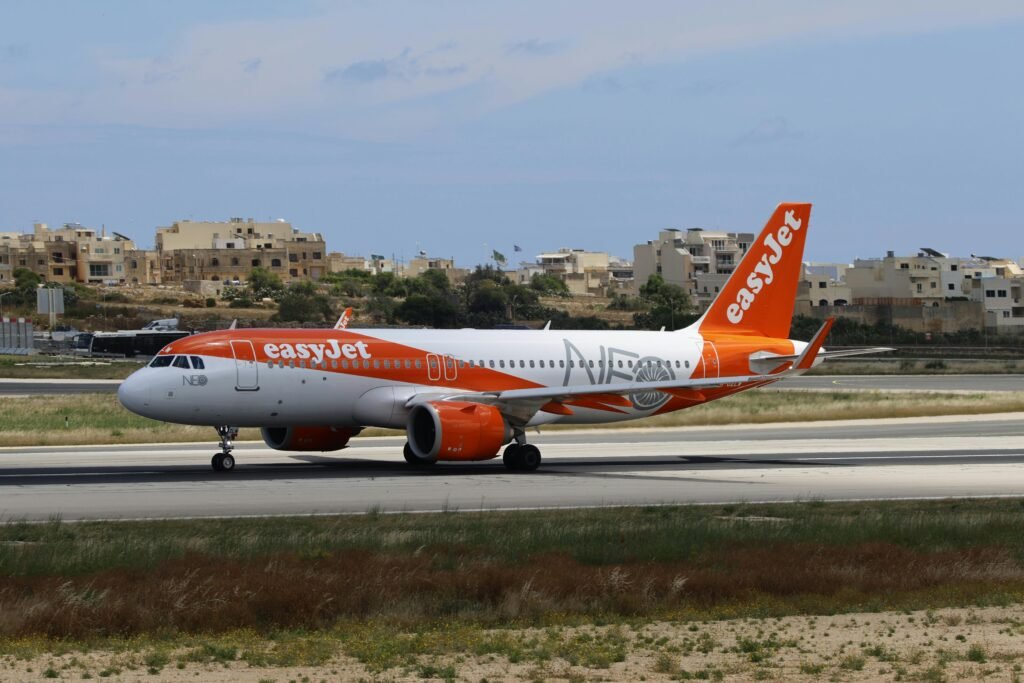A corporate travel policy is more than a simple set of rules for booking flights and hotels. It’s a strategic document that directly impacts your company's finances, employee satisfaction, and operational efficiency. A well-crafted policy can transform travel from a major expense into a competitive advantage, attracting top talent and enabling business growth. Conversely, a poorly designed or outdated policy creates friction, frustrates employees, and leads to uncontrolled spending. The difference often lies in moving beyond a rigid, one-size-fits-all approach to one that is flexible, strategic, and aligned with company culture.
This article moves beyond generic advice to provide a strategic breakdown of real-world corporate travel policy examples from leading companies like Google, Netflix, and Salesforce. We will dissect the core components of their policies, revealing the specific tactics they use to balance cost control with employee autonomy and well-being.
You will gain actionable insights and replicable strategies to help you build or refine your own travel program. Whether you're aiming for greater flexibility, prioritizing sustainability, or simply seeking better financial oversight, these examples offer a clear roadmap. We will explore how these industry leaders structure their guidelines, manage approvals, and leverage technology to create travel policies that actually work.
1. Google's Flexible Travel Policy
Google's approach to corporate travel is a masterclass in balancing employee well-being with fiscal responsibility. Instead of rigid, one-size-fits-all rules, their policy empowers employees with autonomy and choice. This model trusts individuals to make smart, cost-conscious decisions that also prioritize their personal comfort and productivity, making it one of the most referenced corporate travel policy examples in the tech industry.
The core principle is simple: provide clear guidelines and budgets, then let employees operate within them. This fosters a culture of ownership and respect, acknowledging that a well-rested and comfortable employee is a more effective one. It moves away from micromanagement and toward a results-oriented framework.

Strategic Breakdown
Google's policy works by defining clear thresholds rather than specific vendor mandates. This structure gives employees the freedom to tailor their travel to their needs while the company maintains financial control.
- Flight Classes: For domestic or short-haul flights (typically under 6 hours), the standard is economy class. For longer, international flights, business class is approved to ensure employees arrive rested and ready for work.
- Accommodation Flexibility: Employees are given a per-diem limit for hotels. They can book their preferred lodging, whether it’s a boutique hotel or a major chain, as long as it falls within the pre-approved budget.
- Personal Upgrades: A key feature is allowing employees to upgrade their travel at their own expense. If an employee wants to upgrade an economy flight to premium economy for extra legroom, they can pay the difference themselves without a complex approval process.
Actionable Takeaways for Your Policy
Implementing a Google-inspired policy requires trust and clear communication. The goal is to empower, not to restrict.
- Establish Clear Budget Parameters: Instead of mandating specific airlines or hotels, set clear per-diem rates and flight class rules based on trip duration and destination. This gives employees a defined sandbox to play in.
- Implement Smart Approval Workflows: Use travel management software to automate approvals. Standard bookings that fit within policy can be approved instantly, while exceptions (e.g., higher-cost options for a specific reason) are flagged for manager review.
- Leverage Data Analytics: Track spending patterns to identify trends and potential savings. Are employees consistently choosing one airline? This data can be used to negotiate better corporate rates without limiting choice.
- Provide Booking Tool Training: Equip your team with the knowledge to use your booking tools effectively. This ensures they can find policy-compliant options easily. This strategy is similar to how AI travel planners can help individuals find tailored trips, a concept you can explore further with these insights into how AI travel planners tailor trips to every style.
2. Salesforce's Sustainability-First Travel Policy
Salesforce's approach to corporate travel is a powerful blueprint for aligning business objectives with environmental stewardship. Their policy integrates sustainability into every decision, making it a core component rather than an afterthought. This model demonstrates how a large corporation can reduce its carbon footprint while still enabling essential business travel, setting a new standard for responsible corporate travel policy examples.
The central idea is to empower employees with the information and tools needed to make greener travel choices. By prioritizing low-carbon options and offsetting unavoidable emissions, Salesforce fosters a culture of environmental accountability. This shifts the focus from merely cost-efficiency to a more holistic view of a trip's total impact.

Strategic Breakdown
Salesforce’s policy is built on a foundation of measurable actions and clear alternatives, guiding employees toward more sustainable behavior without hindering business operations.
- Carbon Offset Mandate: Every business flight is automatically subject to a carbon offset purchase. The company partners with certified environmental projects to neutralize the emissions generated by air travel, making this a non-negotiable part of the booking process.
- Eco-Friendly Transport Hierarchy: The policy actively promotes lower-emission travel modes. For trips under 500 miles, rail travel is the preferred and often required option over short-haul flights.
- Investment in Virtual Alternatives: Salesforce heavily invests in high-quality virtual collaboration tools, including virtual reality meeting rooms. This provides a compelling alternative to travel, encouraging teams to question whether a physical trip is truly necessary.
Actionable Takeaways for Your Policy
Adopting a sustainability-first model requires a commitment to both technology and cultural change. The goal is to make the greenest choice the easiest choice.
- Integrate Carbon Offsetting: Partner with a reputable carbon offset organization and integrate their services directly into your travel booking platform. Automate the purchase of offsets for all flights to ensure 100% participation.
- Establish a Sustainable Travel Hierarchy: Define clear guidelines that prioritize modes of transport based on their environmental impact. Mandate train travel for shorter distances and encourage ride-sharing or public transit for local movement.
- Provide Impact Transparency: Show employees the carbon footprint of their travel options directly within the booking tool. Displaying C02 emissions for different flights or transportation methods can nudge them toward more responsible decisions.
- Promote Virtual-First Meetings: Before approving travel, require a justification for why a virtual meeting is insufficient. This simple step encourages critical thinking about travel needs and can be especially useful for those learning how to plan international travel for business.
3. Microsoft's Tiered Travel Policy
Microsoft’s approach to corporate travel is a prime example of structured scalability, designed to meet the diverse needs of a massive global workforce. Unlike a one-size-fits-all model, their tiered policy differentiates travel perks based on employee level, trip purpose, and duration. This system effectively balances cost management with the need to provide appropriate comfort and convenience, solidifying its place among the most strategic corporate travel policy examples.
The core philosophy is that not all business travel is created equal. A C-suite executive flying for a high-stakes negotiation has different needs than an individual contributor attending a training seminar. By creating distinct tiers, Microsoft aligns travel expenditure directly with the strategic importance of the trip and the seniority of the employee, ensuring resources are allocated efficiently.
The following diagram illustrates the basic hierarchical structure of Microsoft's tiered travel policy, showing how allowances for flights and approvals scale with employee level.

This visualization clearly shows how the policy creates distinct levels of autonomy and comfort, with executives granted higher approval thresholds and premium travel options.
Strategic Breakdown
Microsoft’s policy is built on clear, predefined categories that remove ambiguity and streamline the booking process for thousands of employees. This segmentation allows the company to control costs at scale while acknowledging the different demands of various roles.
- Executive Tier (C-Level): This tier receives the highest level of flexibility, including business class for flights over three hours and higher per-diem allowances, recognizing the demanding nature and critical importance of their travel.
- Senior Manager Tier: For international or long-haul flights, senior managers are typically approved for premium economy, providing a necessary level of comfort to ensure productivity upon arrival.
- Individual Contributor Tier: The standard for this tier is economy class. However, the policy often includes provisions for upgrades on exceptionally long flights (e.g., over 10 hours) or when specific business needs justify it.
Actionable Takeaways for Your Policy
Adopting a tiered policy requires a clear framework and transparent communication to ensure fairness and prevent confusion. The goal is to create a logical structure that reflects your company's hierarchy and travel needs.
- Define Clear Tier Criteria: Clearly document the criteria for each travel tier. Base these on objective factors like job level, trip purpose, or even frequency of travel to ensure the system is perceived as fair.
- Automate Tier-Based Rules: Use your travel management platform to automatically apply the correct rules based on an employee’s profile. This reduces manual oversight and ensures compliance without administrative bottlenecks.
- Establish an Exception Process: Create a straightforward process for requesting exceptions. A manager may need to approve a business class flight for a junior employee if they are required to present immediately after landing from a long-haul flight.
- Regularly Review and Optimize: Analyze travel data to assess the effectiveness of your tiers. Are there opportunities to save money or improve traveler satisfaction? For more ideas, you can explore insights on how to save money while traveling.
4. Netflix's High-Trust, High-Performance Travel Policy
Netflix's travel and expense policy is famously succinct: "Act in Netflix's best interest." This radical approach replaces a detailed rulebook with a single guiding principle, placing immense trust in employee judgment. It's a prime example of a corporate travel policy that is fully integrated with a company's core culture of freedom and responsibility, empowering individuals to make decisions as if they were spending their own money.
This high-trust model eliminates the need for complex pre-approval workflows and rigid spending limits. The underlying belief is that hiring high-performance individuals and giving them the context and autonomy to do their jobs well naturally leads to responsible spending. The focus shifts from policing expenses to evaluating the business outcomes the travel was meant to achieve.
Strategic Breakdown
Netflix's policy is less about specific rules and more about a cultural mindset. It functions by embedding fiscal responsibility directly into the performance expectations of every employee, ensuring alignment between personal choices and company goals.
- No Pre-Set Limits: There are no explicit per-diems or spending caps for flights, hotels, or meals. Employees are expected to choose options that are practical and efficient for the business purpose of their trip.
- Emphasis on Business Value: The justification for an expense isn't whether it fits a category, but whether it provided value to Netflix. A more expensive direct flight is justified if it saves a day of productivity compared to a cheaper multi-stop option.
- Post-Trip Accountability: While pre-approvals are absent, accountability is not. Manager-employee conversations may occur after a trip, but they focus on the judgment behind the spending decisions and their alignment with business needs, not just the numbers.
Actionable Takeaways for Your Policy
Adopting a Netflix-style policy is a significant cultural shift that requires a strong foundation of trust and accountability. It's not suitable for every organization but offers powerful lessons.
- Build a Culture of Trust First: This policy cannot be implemented in a vacuum. It requires a pre-existing corporate culture where employees are trusted, valued, and held to high standards of performance and judgment.
- Provide Clear Business Context: Employees must understand the company's financial goals and strategic priorities to make informed decisions. Regularly communicate the "why" behind business travel expectations.
- Start with a Pilot Group: Before a full-scale rollout, test the high-trust model with a specific department or team. Use this pilot to identify potential challenges and refine the approach.
- Support Employee Well-being: A high-trust model also means trusting employees to manage their own comfort and safety. Providing resources on topics like how to manage and overcome travel anxiety shows the company supports the whole person, not just the expense report.
5. Deloitte's Consultant-Focused Travel Policy
Deloitte's approach to corporate travel is meticulously crafted for a workforce that is constantly on the move. Designed for the unique demands of the consulting world, the policy prioritizes the productivity and well-being of its "road warriors," who often spend a significant portion of their time at client sites. This model understands that for frequent travelers, comfort is not a luxury but a necessity for maintaining high performance levels, making it a benchmark among corporate travel policy examples in professional services.
The core philosophy is that an efficient, well-rested consultant is a more effective advisor to the client. The policy is therefore structured to reduce travel-related friction and stress, allowing employees to focus on their client engagements. It acknowledges that travel is an integral part of the job and treats it as a strategic component of service delivery, not just an operational cost.
Strategic Breakdown
Deloitte’s policy is built on segmentation and flexibility, recognizing that the needs of a consultant traveling weekly differ vastly from an employee on an occasional trip. The rules are tailored to travel frequency and the nature of client engagements, ensuring both cost control and employee satisfaction.
- Segmented Flight Classes: Consultants who travel over a certain threshold (e.g., more than 50% of the time) are often pre-approved for business class on longer flights. This helps them stay productive and arrive at client meetings ready to perform.
- Premium Accommodation Tiers: For long-term client projects, employees are granted access to premium hotel categories or corporate housing. This provides the comfort and amenities needed for extended stays, such as kitchenettes and fitness centers.
- Flexible Itinerary Changes: Recognizing that client schedules are fluid, the policy includes lenient change and cancellation rules. This is supported by strong negotiated rates with airlines and hotels that allow for last-minute adjustments without incurring excessive fees.
Actionable Takeaways for Your Policy
To implement a consultant-focused policy, you must align travel rules with the high demands placed on your frequent travelers. The goal is to support their work, not hinder it.
- Segment Policies by Travel Frequency: Create different policy tiers for occasional, regular, and heavy travelers. Offer enhanced benefits like better flight classes, higher per diems, and lounge access to employees who travel the most.
- Integrate Travel and Project Systems: Link your travel booking platform with client billing and project management systems. This streamlines the process of assigning travel costs directly to specific projects, simplifying expense reporting and client invoicing.
- Prioritize Traveler Wellness: For those spending extensive time on the road, provide resources like gym membership reimbursements, wellness app subscriptions, and clear guidelines on work-life balance. Ensuring they are well-equipped can be as simple as helping them master their packing routine with a comprehensive business travel packing checklist.
- Negotiate High-Volume Corporate Rates: Leverage your consistent travel volume to secure highly favorable rates and flexible terms with preferred airlines, hotels, and car rental agencies. Emphasize the need for penalty-free changes and cancellations in your negotiations.
6. Airbnb's Local Experience Travel Policy
Airbnb's approach to corporate travel is a powerful extension of its brand identity, encouraging employees to immerse themselves in the company's own ecosystem. Their policy mandates the use of Airbnb properties and promotes local experiences, turning business trips into valuable product research and development opportunities. This strategy brilliantly aligns internal operations with the company mission, making it one of the most unique corporate travel policy examples in the modern business landscape.
The core principle is to have employees "live the product." By staying in Airbnb listings and participating in local activities, staff gain firsthand insights into the customer journey, from booking to checkout. This direct feedback loop is invaluable for product improvement, fostering a deep, empathetic understanding of both hosts and guests.

Strategic Breakdown
Airbnb's policy is designed to be more than just a set of rules; it's a cultural and operational tool. It combines cost-effectiveness with a commitment to its community-based business model, ensuring travel directly contributes to the company's growth.
- Accommodation Mandate: Employees are generally required to book stays through Airbnb for their business travel, especially for trips lasting more than a few nights. This ensures consistent product usage and supports the host community.
- Experience Budget: The policy includes a distinct budget, often around $100 per day, specifically for employees to book local experiences. This encourages them to engage with the platform's offerings beyond just lodging.
- Integrated Feedback Loop: A key component is the requirement for employees to submit detailed trip reports. This feedback is not just for expense claims but is channeled directly to product development teams to identify pain points and areas for innovation.
Actionable Takeaways for Your Policy
Adopting an Airbnb-style policy is about aligning travel with your company's core mission and products, a strategy that can benefit any business.
- Align Travel with Your Mission: Require employees to use your own products or services during business travel where applicable. If you're a software company, have them test new features; if you're a retailer, have them visit your stores in different cities.
- Provide Clear Usage Guidelines: Create guidelines for appropriate property or service selection. For an Airbnb-like model, this might include safety checklists, preferred host ratings, or property types that align with professional standards.
- Establish a Formal Feedback Mechanism: Don’t let employee insights go to waste. Implement a structured process, like a post-trip survey or a dedicated Slack channel, for collecting and analyzing their experiences.
- Create Contingency Plans: Acknowledge that your primary option may not always be available or suitable. Define a clear backup plan, such as approved hotel partners, for situations where policy-compliant options are unavailable.
Corporate Travel Policy Comparison of Top 6 Examples
| Travel Policy | 🔄 Implementation Complexity | 💡 Resource Requirements | 📊 Expected Outcomes | 💡 Ideal Use Cases | ⭐ Key Advantages |
|---|---|---|---|---|---|
| Google's Flexible Travel Policy | Moderate: Requires clear budget guidelines and approval workflows | Moderate: Travel management platform integration, data analytics | High employee satisfaction and productivity | Large enterprises with high-value employees | ⭐ Increased employee comfort and retention |
| Salesforce's Sustainability-First | High: Carbon offsetting, sustainability scoring, virtual tools | High: Investment in carbon offsets and collaboration tools | Reduced travel costs, strong CSR image | Companies prioritizing environmental impact | ⭐ Demonstrates social responsibility |
| Microsoft's Tiered Travel Policy | High: Multi-tier criteria, automated workflows | Moderate-High: Integration with productivity tools | Cost-effective, clear expectations | Large, hierarchical organizations | ⭐ Cost control with role-based fairness |
| Netflix's High-Trust, High-Performance | Low: Minimal rules, relies on culture and judgment | Low: Minimal policy enforcement, relies on performance systems | Maximum flexibility, faster decisions | High-trust, mature cultures with experienced staff | ⭐ Maximum flexibility and minimal overhead |
| Deloitte's Consultant-Focused | High: Tailored for frequent travelers, billing integration | High: Sophisticated travel and billing systems | Reduced burnout, optimized profitability | Consulting firms with frequent business travel | ⭐ High comfort and productivity for road warriors |
| Airbnb's Local Experience | Moderate: Aligns with company mission, feedback integration | Moderate: Budget for local stays and experiences | Cost savings, authentic experiences | Sharing economy companies, culture-focused businesses | ⭐ Supports mission and local community impact |
Building Your Perfect Travel Policy: From Examples to Execution
The journey through these diverse corporate travel policy examples, from Google’s flexible framework to Deloitte’s consultant-centric model, reveals a powerful truth: there is no one-size-fits-all solution. Instead, the most effective policies are a direct reflection of a company's culture, strategic priorities, and operational realities. A great policy is not just a document; it's a strategic asset that empowers employees, controls costs, and reinforces core values.
We've seen how Netflix’s high-trust model thrives on autonomy, while Microsoft's tiered system provides structured clarity. Salesforce champions sustainability, integrating environmental responsibility into every trip, and Airbnb encourages authentic, localized experiences. Each approach offers a unique blueprint, demonstrating that the ultimate goal is to find the perfect equilibrium between flexibility and control, cost savings and employee well-being.
Synthesizing the Key Takeaways
As you move from inspiration to implementation, remember these core principles distilled from the leading corporate travel policy examples we've explored:
- Culture is King: Your policy must align seamlessly with your company's foundational values. A culture of freedom and responsibility, like Netflix's, requires a minimalist policy, whereas a more structured, process-driven organization might benefit from a detailed framework like Microsoft's.
- Clarity Over Complexity: The best policies are easy to understand and follow. Use clear language, logical structures, and accessible formats. A policy that requires a legal team to interpret is a policy that will be ignored.
- Flexibility Breeds Satisfaction: Empowering employees with choice within clear boundaries, as Google does, leads to higher compliance and morale. Rigid, overly restrictive rules often invite workarounds and resentment.
- Technology is Your Ally: Modern travel management platforms are essential for streamlining booking, automating expense reporting, and providing real-time data for duty of care. This technology underpins the efficiency of policies at companies like Salesforce and Deloitte.
Your Actionable Next Steps
Building or refining your corporate travel policy is an iterative process. Start by evaluating your current approach against the innovative strategies discussed. Engage with your key stakeholders, from frequent travelers to finance and HR leaders, to gather feedback and identify pain points. Use the downloadable templates provided earlier as a structural foundation, but customize every section to fit your unique organizational DNA.
Remember, the goal is not to copy another company's policy verbatim. The true value lies in understanding the why behind their choices. Why does a high-trust model work for Netflix? Why does a tiered system benefit Microsoft? Answering these questions for your own organization is the final, crucial step in crafting a policy that not only governs travel but actively contributes to your company's success and your employees' satisfaction. A well-designed policy transforms travel from a logistical hurdle into a strategic advantage, driving business growth and fostering a positive, productive culture.
Ready to put these insights into action with a platform built for modern business travel? The People Travels simplifies the entire process, from policy creation and automated compliance to seamless booking and expense management. Visit The People Travels to see how our intuitive solution can help you build and execute the perfect travel policy for your team.




